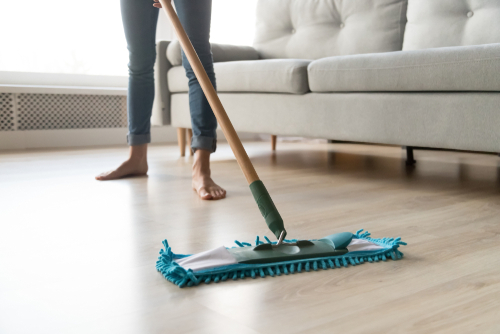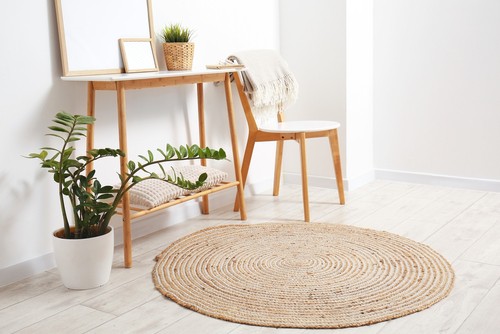
Laminate Flooring and Allergies: A Healthy Home Solution
December 26, 2023
Laminate Flooring Maintenance 101: Dos and Don’ts
March 6, 2024Pairing Rugs with Laminate Flooring

Pairing Rugs with Laminate Flooring
Pairing Rugs with Laminate Flooring. The popularity of laminate flooring has surged in recent years, and for good reason.
Its cost-effectiveness, aesthetic versatility, and ease of installation have made it a top choice for homeowners looking to spruce up their interior spaces.
Alongside this trend, many are also recognizing the added value of incorporating rugs into their living environments.
This guide aims to be your comprehensive resource for understanding how to harmoniously blend rugs and laminate flooring to maximize comfort, aesthetics, and longevity.
Table of Contents
Why Rugs are Imperative on Laminate Flooring
Enhancing Room Aesthetics
Rugs offer the power to instantly transform any space. By adding a layer of texture, color, and pattern, they can make a room feel more inviting, vibrant, or even visually larger.
When laid on laminate flooring, a well-chosen rug can serve as a focal point, drawing attention to specific areas of the room or complementing the existing decor.
Delivering Underfoot Comfort
While laminate flooring is easier on the feet than hardwood or tile, a rug can add an extra layer of cushioning that makes a significant difference in comfort.
Whether you’re walking, standing, or sitting on the floor, a good rug can relieve pressure on your feet and lower back, making your home more comfortable for daily activities and leisure.
Preserving Laminate Floors
Laminate flooring is durable, but it’s not invincible. The impact of furniture legs, pet claws, and a high volume of foot traffic can eventually cause wear and tear.
A rug can act as a barrier, absorbing much of this impact and thereby extending the lifespan of your laminate floors.
Unpacking the Mechanics of Laminate Flooring

Laminate flooring is engineered to mimic the look of natural materials like wood and stone, without the hefty price tag.
Its layered construction, which typically includes a moisture-resistant backing, a high-density core board, a photographic layer, and a protective overlay, provides both visual appeal and functional durability.
The click-lock design found in most laminate flooring also allows for easier installation and repairs.
However, not all rugs are suitable for laminate flooring. Certain rubber or latex-backed rugs can cause discoloration. Additionally, heavier rugs can lead to indentations on the laminate surface over time. Therefore, it’s crucial to choose wisely.
How to Choose the Right Rug
Dimensions
Size is more than just a matter of available floor space; it also affects how the room is perceived.
A too-small rug can make a room look disjointed, while an oversized one can overwhelm the space. Measure the area you want to cover carefully and select a rug that fits within those parameters.
Material
Natural fibers like wool offer exceptional durability and softness but come at a higher cost.
Synthetic fibers like polyester and nylon provide a less expensive option that is also easier to clean. Each material has its advantages and drawbacks, so consider your lifestyle needs when making your selection.
Palette and Designs
Color plays a critical role in setting the mood of a room. Neutral shades can create a calming atmosphere, while vibrant colors can energize the space.
The rug’s pattern should also coordinate with the room’s existing decor for a cohesive look.
Rugs Tailored for Laminate Floors

Wool Rugs
Pros
- Exceptional durability makes them a long-lasting investment.
- Naturally hypoallergenic and resistant to bacteria and dust mites.
- Offers a luxurious, plush feel underfoot.
Cons
- High cost can be a deterrent for some budgets.
- Requires professional cleaning, adding to long-term maintenance costs.
Synthetic Rugs
Pros
- Highly stain-resistant, making them ideal for households with kids or pets.
- Generally less expensive than natural fiber rugs, making them budget-friendly.
- Easier to clean and maintain, often requiring only regular vacuuming and occasional spot cleaning.
Cons
- Not as environmentally friendly due to the use of synthetic materials.
- May emit volatile organic compounds (VOCs), which can affect indoor air quality.
Natural Fiber Rugs
Pros
- Made from renewable resources like jute or sisal, making them eco-friendly.
- Offer a distinct textural element that can add depth to a room’s decor.
Cons
- Generally not as soft underfoot, making them less ideal for play or relaxation areas.
- Can be prone to stains and are generally more challenging to clean.
The Necessity of Rug Pads

Rug pads perform several essential functions. They provide an additional layer of cushioning, enhancing the comfort level of your rug.
More importantly, they keep rugs in place, reducing the risk of slips and falls.
Non-slip pads are generally ideal for smaller rugs or those placed in high-traffic areas.
Cushioning pads, made from materials like memory foam, are better suited for larger rugs in low-traffic zones where comfort is a priority.
Installing a rug pad involves more than just laying it on the floor. For best results, the pad should be about one inch smaller than the rug on all sides to prevent it from showing. Secure it in place with double-sided tape or a non-slip coating.
Placement Paradigms
- In Living Spaces: The rug should ideally be large enough to fit under the front legs of all furniture in the seating area, creating a sense of unity.
- In Bedrooms: In bedrooms, the rug should be large enough to extend beyond the bed by at least 24 inches on each side, providing a soft landing for your feet.
- In High-Traffic Corridors: Runners are the best option for hallways and other narrow, high-traffic areas. Make sure they are wide enough to cover the width of the corridor and long enough to extend the full length.
Maintenance Mantras

Vacuum your rug at least once a week to remove dirt and dust. Spills should be attended to immediately with a damp cloth. For wool or natural fiber rugs, annual professional cleaning is recommended.
Avoid using harsh cleaning chemicals or scrubbing your rug too hard, as this can damage the fibers and potentially void any manufacturer’s warranties.
When cleaning your laminate floors, opt for a microfiber mop dampened with a laminate-approved cleaning solution. Avoid using excess water, as it can seep between the planks and cause swelling.
Financial Considerations
Invest in the best rug you can afford. While it may be tempting to skimp and go for cheaper options, investing in a quality rug will pay off in the long run.
The right rug not only improves your immediate living conditions but also serves as a long-term investment, often lasting for several years when well-maintained.
Frequently Asked Questions

Can any rug be used on laminate flooring?
It’s crucial to check the rug’s material and backing to ensure compatibility with laminate floors.
How to prevent rug slippage?
Use a non-slip rug pad to keep the rug securely in place.
Can rugs cause discoloration on laminate flooring?
Certain rugs with dyes that are not colorfast can cause discoloration. Always do a patch test first.
What’s the recommended cleaning frequency?
Vacuuming once a week and professional cleaning once a year is generally sufficient.
Is a rug pad necessary?
While not mandatory, a rug pad is strongly recommended for both safety and comfort.
Pairing Rugs with Laminate Flooring – Conclusion

Mastering the art of pairing rugs with laminate flooring is about more than just aesthetics; it’s a multi-faceted endeavor that incorporates functionality, comfort, and longevity.
By making informed decisions in rug size, material, and placement, you can significantly enhance the quality of your living environment.
Whether you opt for the natural luxury of a wool rug or the budget-friendly resilience of a synthetic alternative, the key is to choose wisely.
With the right rug, you can make your laminate floors look and feel better, while also extending their lifespan.
By adhering to these guidelines, you can elevate your home’s aesthetic and functional harmony, making it a true sanctuary that speaks to your unique preferences and needs.
Are you seeking a professional and reliable laminate flooring installation or supplier in Singapore? Contact us today!



